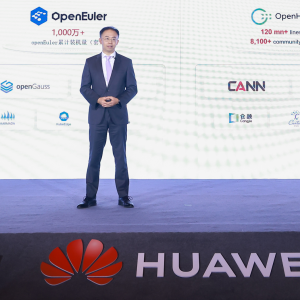Hewlett-Packard Co, which hopes to drive $1 billion in x86-based high performance computing (HPC) cluster sales by 2006 and which is one of the dominant players in the RISC/Unix supercomputing markets (thanks to the considerable HPC server businesses from both Compaq and HP), is launching a new integrated cluster offering called the Unified Cluster Portfolio.
HP, like the other server makers who also either build HPC clusters themselves or do so in conjunction with partners, are chasing one of the few solidly growing markets in the server space. According to IDC, the overall HPC market will grow from about $5.5bn in 2003 to about $7.5bn in 2008. The traditional SMP-based, RISC/Unix HPC server market is expected to shrink from around $3.5bn in 2003 to $2.5bn by 2008, while the cluster portion of the market, which is overwhelmingly dominated by Linux-based X86 clusters, will grow from about $2.5bn in 2003 to $5bn by 2008.
In the first half of 2004, HP had 31.5% of the overall HPC server market, which accounted for $3.4bn, followed by IBM with 30.3%. Sun Microsystems accounted for 17% of the market in the first half of 2004, with Dell getting 7.3%, SGI having 4.1%, NEC attaining 1.3%; Cray, Fujitsu, and Hitachi all got a fraction of a percent of market share so far this year.
In the latest market stats for clusters that are preconfigured by vendors and sold as complete systems, HP, Dell, and IBM dominate, with 30.4%, 24.2%, and 22.9% market shares, respectively.
For HP, the Unified Cluster Portfolio is comprised of Integrity servers (which use Itanium processors) and ProLiant servers (which have either Xeon or Opteron processors). Specifically, HP is offering standard 512-node configurations with choices of operating systems and interconnections, plus optional HPC application software installation, all orderable with a single product number and all supported as a single product.
The Cluster Platform 3000 is based on two-way DL360 G4 servers, which use the new Intel Nocona Xeon-64 processors; the Cluster Platform 4000 is based on the DL145, which is a two-way machine based on the 200 series of the AMD Opteron processors; and the Cluster Platform 6000 is based on the existing two-way rx2600 Itanium servers and the new rx1620 and rx2620 Itanium servers that HP is debuting today.
HP is supporting Linux, HP-UX, and Windows on these cluster platforms (HP-UX is only available on the Itanium boxes), and is weaving in its own cluster management and HPC software (such as math libraries, Message Passing Interface [MPI] protocols, and other tools) into the offering. HP is also weaving in its StorageWorks Scalable File Share, which is a cluster file system based on the Lustre open source project (which runs on Linux), and will also in the second quarter of 2005 launch a visualization front end called the Scalable Visualization System for these clusters that will gang up industry-standard 3D graphics cards in parallel and turn them into a giant virtual graphics card that can render 100 million or more pixels. This is accomplished with a set of software created by HP in conjunction with the HPC community called Sepia.
For all of the different technology included in the Unified Cluster Portfolio, Ed Turkel, manager of HPC product marketing for HP, the integration of the products at HP’s factories (which costs a few points more than buying parts separately) as well as providing a single warranty for the entire cluster are going to make life for HPC customers considerably easier.
While IBM has been making a lot of noise this week concerning its Blue Gene/L Linux-based supercomputer, it still has to push its Power5-based Squadron servers that actually drive billions of dollars a year in AIX server sales, mainly because in the past decade, IBM has sold a lot of parallel Unix servers based on the Power architecture and there are tons of programs that have been written for these machines. But IBM is not quite ready to ship HPC variants of the Power5-based eServer p5 machines.
So this week, IBM put out a technology preview of the future p5 575 HPC cluster nodes. These future HPC nodes, which are due in the first quarter of 2005, will cram eight Power5 processor cores (running at 1.9GHz) and 64 main memory slots into a rack-based, 2U form factor.
It looks like the p5 575 is implementing one of the multichip modules that is used in the 64-way p5 590 and 595 servers rather than ganging up four of the two-way processors that are used in the p5 520, 550, and 570 boxes. With 4GB DIMMs, this eight-way server will be able to support 256GB of main memory and it will have 144MB of L3 cache memory that is shared by all eight Power5 cores. I
BM plans to support AIX 5L V5.2 and V5.3 on this p5 575 server, as well as Novell’s SuSE Linux Enterprise Server 9 and Red Hat’s Enterprise Linux 3 AS. The full suite of logical partitioning and virtualization features of the AIX platform will be available on this server, but customers will have to be on AIX V5.3 to get all of the most sophisticated features, such as micropartitioning, Virtual LAN, and Virtual I/O.
This server will plug into the existing Federation High Performance Switch, but IBM says it will take until the second quarter to deliver this HPS support. For those who can get by with Gigabit Ethernet for clustering, each server will have four such ports.
Over at Sun, the company will be talking up its plan to sell computing capacity to HPC customers at the rate of $1 per CPU per hour, but this offering is not actually available yet, so this is mostly a theoretical discussion. Sun is also announcing that it has expanded its partnership with Topspin Communications and now supports the Solaris operating system on its Opteron-based Sun Fire V20z and V40z servers with its InfiniBand switching products alongside Windows and Linux platforms. Sun and Topspin have been partners since March 2003, and have been doing joint marketing since that time. Now, they will work together on deals and qualify Sun’s hardware to cooperate with Topspin’s gear.
Sun is also announcing that the Stanford Linear Accelerator Center has acquired 296 two-way Sun Fire V20z Opteron servers through a grant from the US Department of Energy to create a Solaris 10 cluster running Sun’s Grid Engine grid computing middleware. SLAC already has 1,000 Sun systems and over 400 TB of Sun disk storage to support its advanced physics research. (This stands to reason, considering that Sun’s founders were Stanford graduates and that Sun – which actually is an acronym for Stanford University Network – is tied very tightly to Stanford. If Sun didn’t get the Solaris cluster deal at SLAC, that would be bigger news.)
SLAC is not the only HPC deal Sun that is announcing. The University of Nottingham has tapped Sun and software maker Streamline Computing to build a 500+ node cluster of V20z servers running Grid Engine with a peak processing capacity of 3 teraflops. The cluster will use the 2.4GHz variants of the Opteron 250 processors and will use a Gigabit switched fabric from 3Com to lash the machines together.
The cluster will also run Streamline’s Cluster Management and Administration tool and Allinea’s distributed debugging and optimization tools. Allinea is a software spinout from Streamline, and both companies are based in the UK. With HPC, there is almost always a political angle because of the sources of the money behind clusters: universities and governments.
At the SC2004 show, Dell is announcing a new server, the PowerEdge 1425, which is a 1U server with two Xeon-64 processors with 800MHz frontside buses and up to 12GB of main memory; it also includes dual Gigabit Ethernet ports on its main board. The PowerEdge 1450 is a cut-down version of the new PowerEdge 1850 server that Dell announced a few weeks ago with Linux support from Novell.
A base PowerEdge 1450 costs $1,099, and it can be equipped with Windows Server 2003 Web or Standard Edition or Red Hat Enterprise Linux 3. (This server can run those operating systems in 32-bit or 64-bit modes.) Dell is selling the PowerEdge 1450s in HPC bundles, which it calls the PowerEdge SC, with 8, 16, 32, 64, 128, or 256 nodes. An eight-node cluster of these servers costs $33,500 with barebones configurations and no operating systems.






